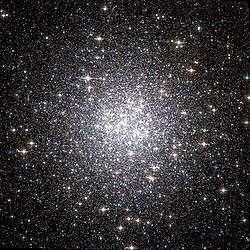Messier 53
| Messier 53 | |
|---|---|
 | |
| Observation data (J2000 epoch) | |
| Class | V[1] |
| Constellation | Coma Berenices |
| Right ascension | 13h 12m 55.25s[2] |
| Declination | +18° 10′ 05.4″[2] |
| Distance | 58×103 ly (18 kpc)[3] |
| Apparent magnitude (V) | +8.33[4] |
| Apparent dimensions (V) | 13.0′[5] |
| Physical characteristics | |
| Mass | 8.26×105[6] M☉ |
| Metallicity | = –1.86[7] dex |
| Estimated age | 12.67 Gyr[7] |
| Other designations | M53, NGC 5024, GCl 22, C 1310+184[4] |

Messier 53 (also known as M53 or NGC 5024) is a globular cluster in the Coma Berenices constellation. It was discovered by Johann Elert Bode in 1775. M53 is one of the more outlying globular clusters, being about 60,000 light-years (18.4 kpc) light-years away from the Galactic Center, and almost the same distance (about 58,000 light-years (17.9 kpc)) from the Solar system. The cluster has a core radius (rc) of 2.18 pc, a half-light radius (rh) of 5.84 pc, and a tidal radius (rtr) of 239.9 pc.[8]
This is considered a metal-poor cluster and at one time was thought to be the most metal-poor cluster in the Milky Way.[8] Abundance measurements of cluster members on the red giant branch show that most are first-generation stars. That is, they did not form from gas recycled from previous generations of stars. This differs from the majority of globular clusters that are more dominated by second generation stars. The second generation stars in NGC 5024 tend to be more concentrated in the core region. Overall, the stellar composition of cluster members is similar to members of the Milky Way halo.[9]
The cluster displays various tidal-like features including clumps and ripples around the cluster, and tails along the cluster's orbit in an east-west direction. A tidal bridge-like structure appears to connect M53 with the close, very diffuse neighbor NGC 5053, as well as an envelope surrounding both clusters. These may indicate a dynamic tidal interaction has occurred between the two clusters; a possibly unique occurrence within the Milky Way since there are no known binary clusters within the galaxy.[10] In addition, M53 is a candidate member of the Sagittarius dwarf galaxy tidal stream.[8]
Among the variable star population in the cluster, there are 55 known to be RR Lyrae variables. Of these, a majority of 34 display behavior typical of the Blazhko effect, including 23 of type RRc – the largest known population of the latter in any globular cluster.[11] There are also at least three variables of type SX Phe and a semi-regular red giant.[12]
References
- ↑ Shapley, Harlow; Sawyer, Helen B. (August 1927), "A Classification of Globular Clusters", Harvard College Observatory Bulletin, 849 (849): 11–14, Bibcode:1927BHarO.849...11S.
- 1 2 Goldsbury, Ryan; et al. (December 2010), "The ACS Survey of Galactic Globular Clusters. X. New Determinations of Centers for 65 Clusters", The Astronomical Journal, 140 (6): 1830–1837, arXiv:1008.2755, Bibcode:2010AJ....140.1830G, doi:10.1088/0004-6256/140/6/1830.
- ↑ Hessels, J. W. T.; et al. (November 2007), "A 1.4 GHz Arecibo Survey for Pulsars in Globular Clusters", The Astrophysical Journal, 670 (1): 363–378, arXiv:0707.1602, Bibcode:2007ApJ...670..363H, doi:10.1086/521780
- 1 2 "NGC 5024". SIMBAD. Centre de données astronomiques de Strasbourg. Retrieved 16 November 2006.
- ↑ Messier 53, SEDS Messier pages
- ↑ Boyles, J.; et al. (November 2011), "Young Radio Pulsars in Galactic Globular Clusters", The Astrophysical Journal, 742 (1): 51, arXiv:1108.4402, Bibcode:2011ApJ...742...51B, doi:10.1088/0004-637X/742/1/51.
- 1 2 Forbes, Duncan A.; Bridges, Terry (May 2010), "Accreted versus in situ Milky Way globular clusters", Monthly Notices of the Royal Astronomical Society, 404 (3): 1203–1214, arXiv:1001.4289, Bibcode:2010MNRAS.404.1203F, doi:10.1111/j.1365-2966.2010.16373.x.
- 1 2 3 Boberg, Owen M.; et al. (May 2015), "Chemical Abundances in NGC 5053: A Very Metal-poor and Dynamically Complex Globular Cluster", The Astrophysical Journal, 804 (2): 12, arXiv:1504.01791, Bibcode:2015ApJ...804..109B, doi:10.1088/0004-637X/804/2/109, 109.
- ↑ Boberg, Owen M.; et al. (June 2016), "Chemical Abundances in NGC 5024 (M53): A Mostly First Generation Globular Cluster", The Astrophysical Journal, 824 (1): 15, Bibcode:2016ApJ...824....5B, doi:10.3847/0004-637X/824/1/5, 5.
- ↑ Chun, Sang-Hyun; et al. (February 2010), "A Wide-Field Photometric Survey for Extratidal Tails Around Five Metal-Poor Globular Clusters in the Galactic Halo", The Astronomical Journal, 139 (2): 606−625, arXiv:0912.3540, Bibcode:2010AJ....139..606C, doi:10.1088/0004-6256/139/2/606
- ↑ Arellano Ferro, A.; et al. (February 2012), "The unusually large population of Blazhko variables in the globular cluster NGC 5024 (M53)", Monthly Notices of the Royal Astronomical Society, 420 (2): 1333−1346, arXiv:1111.0216, Bibcode:2012MNRAS.420.1333A, doi:10.1111/j.1365-2966.2011.20119.x.
- ↑ Bramich, D. M.; et al. (August 2012), "Investigation of variable star candidates in the globular cluster NGC 5024 (M53)", Monthly Notices of the Royal Astronomical Society, 424 (4): 2722−2732, arXiv:1205.5112, Bibcode:2012MNRAS.424.2722B, doi:10.1111/j.1365-2966.2012.21360.x.
External links
| Wikimedia Commons has media related to Messier 53. |
- SEDS: Messier Object 53
- Messier 53, Galactic Globular Clusters Database page
- Gray, Meghan. "M53 – Globular Cluster". Deep Space Videos. Brady Haran.
- Messier 53 on WikiSky: DSS2, SDSS, GALEX, IRAS, Hydrogen α, X-Ray, Astrophoto, Sky Map, Articles and images
